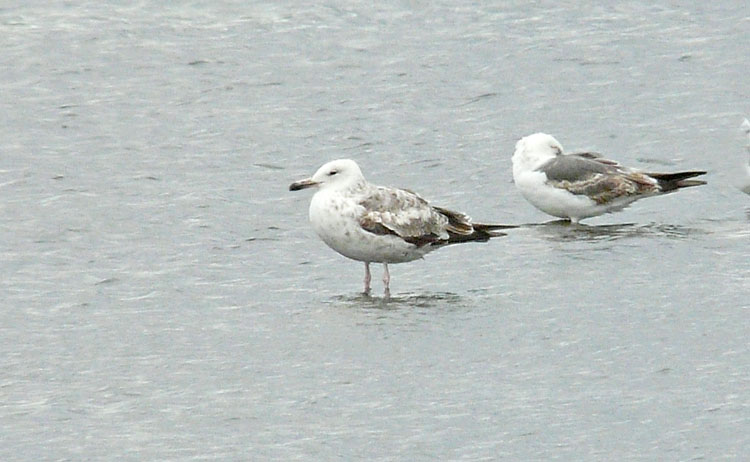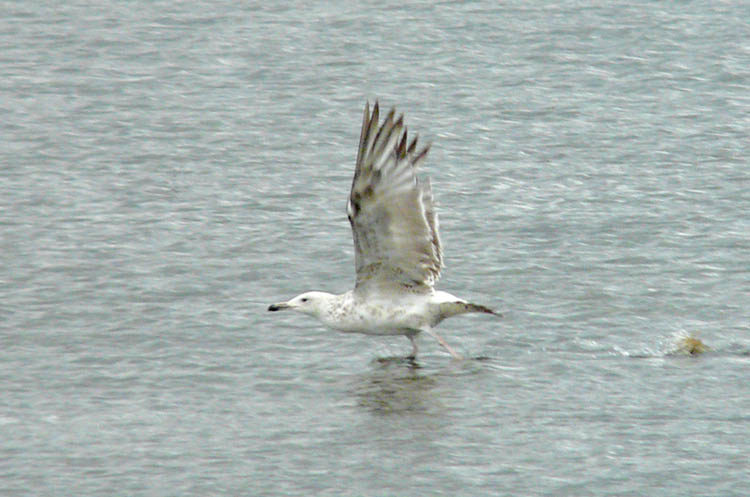Caspian Gull Larus cachinnansA difficult second calendar-year (1S), June 13th 2011, Warks |



© A. R. Dean
'Classic' Caspian Gulls, examined thoroughly and in good light, should not provide too many problems but, as has been said in relation to another species: reference to 'classic' birds often means 'most distinctive' and not necessarily 'most typical' or 'most numerous'. Thus, individuals which require a good deal of judgement can be expected to occur not infrequently. In summer, when gulls are worn and in heavy moult, the problems are further exacerbated, as the definitive patterns of feather tracts can be obscured as a result of feather loss or bleaching. Few Caspian Gulls reach central England in summer but, when they do, their identification can be especially challenging. Also, hybridisation between Caspian and HG, and to a lesser extent with YLG, is now occurring in eastern Europe and colour-ringed hybrids have been encountered in the UK (see for example: www.magikbirds.com/image.asp?title_id=1102). Detecting signs of hybrid influence can be demanding and no more so than with individuals which are worn and in moult.
The 2cy gull in the images above, which is moulting from first-summer into second-winter plumage, illustrates such a worn and bleached individual. It was photographed at the RSPB Middleton Lakes Reserve in mid-June 2011. The lesser and median coverts are very worn and bleached (especially the former) while a significant number of greater coverts and some tertials have been dropped. It is a large and bulky individual, presumably a male. With the resulting loss of feather detail, identification was made hesitantly but teh following features conformed with an 'acceptable' 2cy Caspian Gull : (a) the characteristic shape, with long parallel-sided bill, sloping forehead, deep body profile behind legs (creating ‘boat-shaped’ underbody), long primary projection, and long, spindly, pale pink legs with very prominent tibia; (b) relatively clean, whitish head and underparts for a 2cy LWHG; (c) streaking on lower, rear of neck, creating a shawl; (d) already quite-extensive grey in mantle and scapulars; (e) solidly blackish bases to tertials with new inner (‘upper’) tertials having same plain dark base as first-generation feathers and white prominent only at tips; and (f) extensively pale underwing (in the third image, some 'ghosting' of the upperwing pattern is visible through the wing). Note also the relatively small-looking eye and the bill-colour, with black tip diffusing into greyish-flesh base.
Interestingly, two other gulls during this period initially suggested Caspian Gulls but more thorough examination (including of photographs) revealed anomalous features. One at least seemed likely to have ‘mixed genes’ at some level while the other showed some features more suiting cachinnans but others more suiting michahellis. Correspondingly, I discussed all three individuals with Chris Gibbins, lead author of the paper on Caspian Gull identification in the March 2010 edition of British Birds, who confirmed from photographs that the original bird was fine for Caspian Gull ('I can't see any argument against it, either structurally or plumage wise') but that the other two individuals were problematic. For an example of another challenging individual in the West Midlands region see here.
The issue of natural character variation versus hybrid influence in Caspian Gulls is of increasing relevance and is explored by Chris Gibbins and co. in 'Part 2' of the BB paper (December 2011). It is essential reading.
|
|
|
|
Home |
Mediterranean
| Laughing |
Franklin's |
Little |
Sabine's |
Bonaparte's |
Black-headed |
Ring-billed | Common |
Lesser Black-backed | |